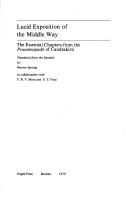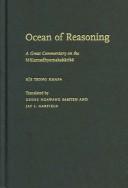| Listing 1 - 10 of 20 | << page >> |
Sort by
|

ISBN: 0877737118 Year: 1979 Publisher: Boulder Prajna
Abstract | Keywords | Export | Availability | Bookmark
 Loading...
Loading...Choose an application
- Reference Manager
- EndNote
- RefWorks (Direct export to RefWorks)

ISBN: 0937938394 Year: 1987 Publisher: Ithaca (N.Y.): Snow lion
Abstract | Keywords | Export | Availability | Bookmark
 Loading...
Loading...Choose an application
- Reference Manager
- EndNote
- RefWorks (Direct export to RefWorks)
Mādhyamika (Buddhism) --- Sunyata --- Psychology --- Nāgārjuna,
Book
ISBN: 9781498555692 9781498555708 1498555705 1498555691 Year: 2018 Publisher: Lanham, MD: Lexington books,
Abstract | Keywords | Export | Availability | Bookmark
 Loading...
Loading...Choose an application
- Reference Manager
- EndNote
- RefWorks (Direct export to RefWorks)
Beginning with the earliest strata of Indian philosophy, this book uncovers a distinct tradition of skepticism in Indian philosophy through a study of the “three pillars” of Indian skepticism near the beginning, middle, and end of the classical era: Nāgārjuna (c. 150-200 CE), Jayarāśi (c. 770-830 CE), and Śrī Harṣa (c. 1125-1180 CE). Moving beyond the traditional school model of understanding the history of Indian philosophy, this book argues that the philosophical history of India contains a tradition of skepticism about philosophy represented most clearly by three figures coming from different schools but utilizing similar methods: Nāgārjuna, Jayarāśi, and Śrī Harṣa. This book argues that there is a category of skepticism often overlooked by philosophers today: skepticism about philosophy, varieties of which are found not only in classical India but also in the Western tradition in Pyrrhonian skepticism. Skepticism about philosophy consists of intellectual therapies for those afflicted by the quest for dogmatic beliefs. The book begins with the roots of this type of skepticism in ancient India in the Ṛg Veda, Upaniṣads, and early Buddhist texts. Then there are two chapters on each of the three major figures: one chapter giving each philosopher’s overall aims and methods and a second demonstrating how each philosopher applies these methods to specific philosophical issues. The conclusion shows how the history of Indian skepticism might help to answer philosophy’s detractors today: while skeptics demonstrate that we should be modest about philosophy’s ability to produce firm answers, philosophy nonetheless has other uses such as cultivating critical thinking skills and lessening dogmatism. This book is situated within a larger project of expanding the history of philosophy. Just as the history of Western philosophy ought to inform contemporary philosophy, so should expanding the history of philosophy to include classical India illuminate understandings of philosophy today: its value, limits, and what it can do for us in the 21st century.
Skepticism --- Philosophy, Indic. --- Nāgārjuna, --- Jayarāśibhaṭṭa, --- Śrīharṣa,

ISBN: 1280835532 0195349040 142943841X 9781429438414 0195147324 9780195147322 0195147332 9780195147339 0197740286 Year: 2006 Publisher: New York Oxford University Press
Abstract | Keywords | Export | Availability | Bookmark
 Loading...
Loading...Choose an application
- Reference Manager
- EndNote
- RefWorks (Direct export to RefWorks)
'An Ocean of Reasoning' is the most extensive and perhaps the deepest extant commentary on Nagarjuna's 'Mulamadhyamakakarika', and it can be argued that it is impossible to discuss Nagarjuna's work in an informed way without consulting it.
Mādhyamika (Buddhism) --- Nāgārjuna, --- M�adhyamika (Buddhism) --- N�ag�arjuna, --- Madhyamika (Buddhism) --- Nagarjuna,
Book
ISBN: 9781935413035 1935413031 Year: 2009 Publisher: Seattle: Kalavinka press,
Abstract | Keywords | Export | Availability | Bookmark
 Loading...
Loading...Choose an application
- Reference Manager
- EndNote
- RefWorks (Direct export to RefWorks)
This is a very detailed commentary on the meaning of each stanza comprising Arya Nagarjuna's Treatise on the Provisions for Enlightenment. It is the only extant commentary on this important work by Nagarjuna. Translation and clarifying notes by Bhikshu Dharmamitra. Includes facing-page source text in both traditional and simplified scripts. (See the "Book Excerpt" links below for a complete description of the contents.)
Dissertation
Abstract | Keywords | Export | Availability | Bookmark
 Loading...
Loading...Choose an application
- Reference Manager
- EndNote
- RefWorks (Direct export to RefWorks)
Buddhism --- Bouddhisme --- Sacred books --- Livres sacrés --- Nāgārjuna, Siddha
Book
Year: 1959 Publisher: Paris : Adrien-Maisonneuve,
Abstract | Keywords | Export | Availability | Bookmark
 Loading...
Loading...Choose an application
- Reference Manager
- EndNote
- RefWorks (Direct export to RefWorks)
Mādhyamika (Buddhism) --- Mādhyamika (Bouddhisme) --- Nāgārjuna, --- Nāgārjuna, --- Mādhyamika (Buddhism) --- Mādhyamika (Bouddhisme)
Book
ISBN: 9780197771303 Year: 2024 Publisher: New York : Oxford University Press,
Abstract | Keywords | Export | Availability | Bookmark
 Loading...
Loading...Choose an application
- Reference Manager
- EndNote
- RefWorks (Direct export to RefWorks)
"Nagarjuna is generally accepted by Buddhists and Buddhiologists alike as one of the most important of all Buddhist thinkers. Indeed, his thought has been core to the historical shaping and reshaping of Buddhism throughout South-, Central-, and East-Asia. It continues to fascinate, moreover, as evinced by the plethora of recently published inspirational and intellectual works devoted to him by adherents and academics. Recent scholarly interest in Nagarjuna has been intense, with especial focus on the vexed question of the rationality, or irrationality, of his thought. For understandable reasons, debates in this regard have gravitated toward two points of friction between the arguments Nagarjuna laid out in India almost two millennia ago and those considered acceptable by his philosophically minded interpreters today, trained as these latter have typically been in twentieth-century Western analytical philosophy. Briefly stated, the issues at question relate, firstly, to Nagarjuna's use or tetra lemma, according to which a proposition may be true, false, both true and false, or neither true nor false; and secondly, to Nagarjuna's espousal of the "abandonment of all views""--
Mādhyamika (Buddhism) --- Buddhist philosophy --- Buddhist philosophy. --- Mādhyamika. --- Philosophie bouddhique --- History. --- Histoire. --- Nāgārjuna, --- Nāgārjuna,

ISSN: 0755172X ISBN: 2226122273 9782226122278 Year: 2001 Publisher: Paris: Albin Michel,
Abstract | Keywords | Export | Availability | Bookmark
 Loading...
Loading...Choose an application
- Reference Manager
- EndNote
- RefWorks (Direct export to RefWorks)
Sunyata. --- Madhyamika (Buddhism) --- 'Sunyata --- Madhyamika (Bouddhisme) --- Nagarjuna, --- Madhyamika (Bouddhisme). --- Mādhyamika (Buddhism) --- ʹSūnyatā --- Mādhyamika (Bouddhisme) --- Nāgārjuna,
Book
ISBN: 9781935413158 1935413155 Year: 2019 Volume: 14 Publisher: Seattle: Kalavinka press,
Abstract | Keywords | Export | Availability | Bookmark
 Loading...
Loading...Choose an application
- Reference Manager
- EndNote
- RefWorks (Direct export to RefWorks)
"Nāgārjuna on Mindfulness of the Buddha" consists of three extended passages from Bhikshu Dharmamitra's original annotated translations from Sino-Buddhist Classical Chinese of works written by Ārya Nāgārjuna (circa 150 ce). All three of these passages have been selected from Tripitaka Master Kumārajīva's early Fifth Century Sanskrit-to-Chinese translations of works by Nāgārjuna, as follows: 1) "The Easy Practice" -- Nāgārjuna's Treatise on the Ten Grounds, Chapter 9; 2) "The Pratuyutpanna Samādhi" -- Nāgārjuna's Treatise on the Ten Grounds, Chapters 20-25; and 3) "Recollection of the Buddha" -- Nāgārjuna's Exegesis on the Mahāprajnāpāramitā Sūtra, Chapter 1, Part 36-1 This special bilingual edition (English / Chinese) includes the facing-page simplified and traditional Chinese scripts to facilitate close study by academic buddhologists, students in Buddhist universities, and Buddhists in Taiwan, Hong Kong, Mainland China, and the West."
Bodhisattva stages (Mahayana Buddhism) --- Pure Land Buddhism --- Doctrines --- Nāgārjuna, --- Criticism, interpretation, etc. --- Tripiṭaka. --- Bodhisattva bhūmis --- Fifty-two stages (Mahayana Buddhism) --- Ten stages (Mahayana Buddhism) --- Religious life --- Mahayana Buddhism --- Daśabhūmīśvara --- Daśabhūmikasūtra --- Daśabhūmika-sūtra --- 294.3*92 --- 294.3*92 Mahayanaboeddhisme--(noordelijk Boeddhisme) --- Mahayanaboeddhisme--(noordelijk Boeddhisme) --- Bodhisattva stages (Mahayana Buddhism) - Early works to 1800 --- Pure Land Buddhism - Doctrines - Early works to 1800 --- Nāgārjuna, - active 2nd century. - Daśabhūmivibhāṣāśāstra - Criticism, interpretation, etc. --- Nāgārjuna, - active 2nd century. - Daśabhūmivibhāṣāśāstra
| Listing 1 - 10 of 20 | << page >> |
Sort by
|

 Search
Search Feedback
Feedback About UniCat
About UniCat  Help
Help News
News